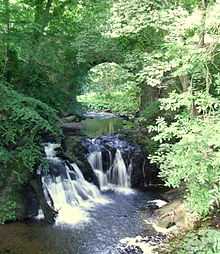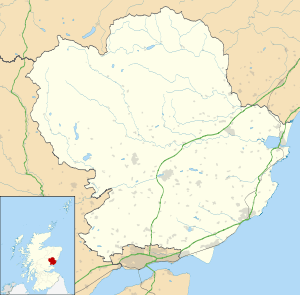Arbirlot
Coordinates: 56°33′26″N 2°38′48″W / 56.557153°N 2.64675°W
Arbirlot (Gaelic: Obar Eilid) is a village in a rural parish of the same name in Angus, Scotland. The current name is a contraction of Aberelliot - mouth of the Elliot.[1] It is situated west of Arbroath. The main village settlement is on the Elliot Water, 2.5 miles from Arbroath. There is a Church of Scotland church and a primary school. The school lies 1 mile further west in the approximate geographic centre of the parish.

A nature trail by the Elliot Water links Arbirlot with the former railway junction of Elliot on the Angus Coast. Arbirlot holds host to a spectacular 23 foot waterfall.
History
Kelly Castle (sometimes Kellie Castle or Auchterlony Castle),[2] which overlooks the Elliot Water, comprises a four-storey tower of the late 15th or early 16th Century, set within a 19th-century courtyard. It was a stronghold of the Mowbray family until forfeited to the Stewarts in the early 14th century and was restored from a semi-ruined state [2] by the Earl of Dalhousie in the 19th century.
In the 18th and 19th centuries Arbirlot was principally occupied by handloom weavers and farmers, Arbirlot once had a meal mill, a slaughterhouse, two schools, a post office, a savings bank, an inn, a parish library as well as a number of shops.[1][3]
The parish is believed to be the original home of Clan Elliot, which was transplanted in the Scottish Borders to defend the newly crowned Robert the Bruce's Scotland from English invaders through an intricate network of peel towers. The Elliots joined the clans of Armstrong, Scott, Douglas, Kerr, Nixon, Hepburn and Maxwell in this effort. The Border Reivers and other titles such a Outlaws of the Marshes are most informative about the Elliots and their exploits after leaving the Arbirlot parish.
Notable natives and residents
- George Gladstanes c.1562 – 1615, minister in Arbirlot c.1592 - 1597, afterwards Bishop of Caithness and later Archbishop of St Andrews
- John Guthrie c. 1580 - 1649, minister in Arbirlot 1603 - 1617, afterwards Bishop of Moray. Supporter of Charles I's religious policies.
- Alexander McGill (c.1680-1734), mason and architect. First City Architect of Edinburgh.
- Rev Thomas Guthrie 1803 – 1873, divine and philanthropist, minister in Arbirlot 1827–1837
- Rev John Kirk 1795–1858, divine and biographer (of Susannah Wesley mother of John Wesley, The Mother of the Wesleys, Jarrold, London 1868), Church of Scotland minister in Arbirlot 1837 – 1843 and later first Free Church of Scotland minister in Arbirlot
- Alexander Carnegie Kirk 1830 - 1892, engineering innovator - particularly of the marine triple expansion steam engine. Elder son of the Rev John Kirk
- Sir John Kirk 1832 – 1922, physician, naturalist, companion to explorer David Livingstone, diplomat, slavery abolitionist and photography pioneer, lived with his parents in Arbirlot as a young man. Younger son of the Rev John Kirk.
- Eileen Ramsay (born 1940), novelist
See also
Arbirlot Railway Station
Arbirlot Primary School
Elliot Water
List of listed buildings in Arbirlot, Angus
References
Ordnance Gazetteer of Scotland: A Survey of Scottish Topography, Statistical, Biographical and Historical, edited by Francis H. Groome Thomas C. Jack, Grange Publishing Works, Edinburgh between 1882 and 1885
- ↑ 1.0 1.1 Statistical Account of Scotland, edited by Sir John Sinclair of Ulbster, Edinburgh 1791-99
- ↑ 2.0 2.1 RCAHMS Canmore Database - see External Links
- ↑ New Statistical Account of Scotland, General Assembly of the Church of Scotland , Edinburgh 1834-45
External links
| Wikimedia Commons has media related to Arbirlot. |
- Description of Arbirlot Parish Church
- Description of the former Arbirlot Free Church
- Church website
- Parish Records
- Arbirlot in the First Statistical Account of Scotland
- Arbirlot in the Second Statistical Account of Scotland
- Kelly Castle record at Royal Commission on the Ancient and Historical Monuments of Scotland
